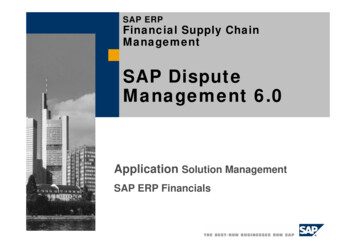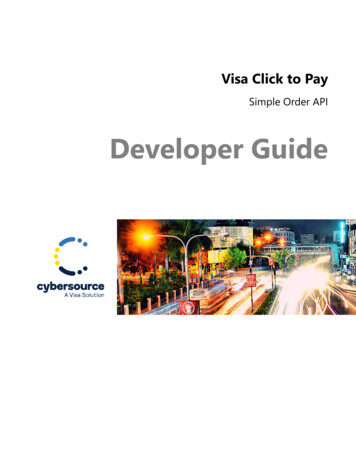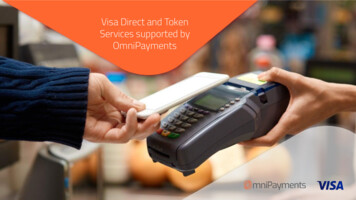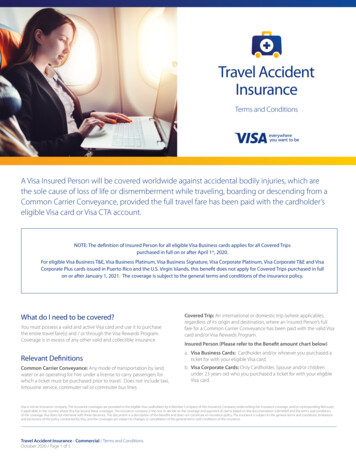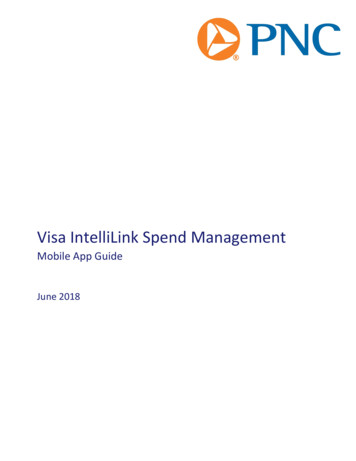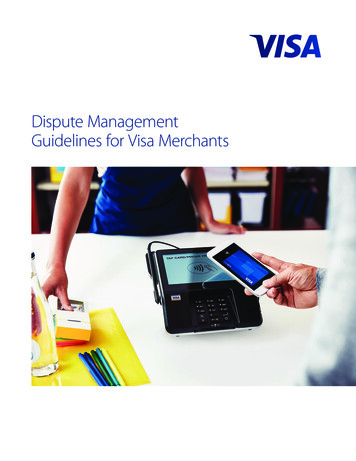
Transcription
Dispute ManagementGuidelines for Visa Merchants
Table of ContentsContentsIntroduction . . . . . . . . . . . . . . . . . . . . . . . . . . . . . . . . . . . . . . . . . . . . . . . . . . . . . . . . . . . . . . . . . . . . . . . . . . 1SECTION 1 Getting Down to Basics . . . . . . . . . . . . . . . . . . . . . . . . . . . . . . . . . . . . . . . . . . . . . . . . . 4Disputes Overview . . . . . . . . . . . . . . . . . . . . . . . . . . . . . . . . . . . . . . . . . . . . . . . . . . . . . . . . . . . . . . . . . . . 5SECTION 2 Copy Requests . . . . . . . . . . . . . . . . . . . . . . . . . . . . . . . . . . . . . . . . . . . . . . . . . . . . . . . . . 7Transaction Receipt Requirements – Card-Present Merchants . . . . . . . . . . . . . . . . . . . . . . . . . 8Substitute Transaction Receipt Requirements – Card-Absent Merchants . . . . . . . . . . . . . . 9Responding to Copy Requests . . . . . . . . . . . . . . . . . . . . . . . . . . . . . . . . . . . . . . . . . . . . . . . . . . . . . . 10How to Minimize Copy Requests . . . . . . . . . . . . . . . . . . . . . . . . . . . . . . . . . . . . . . . . . . . . . . . . . . . 11SECTION 3 Disputes . . . . . . . . . . . . . . . . . . . . . . . . . . . . . . . . . . . . . . . . . . . . . . . . . . . . . . . . . . . . . . 13Why Disputes Occur . . . . . . . . . . . . . . . . . . . . . . . . . . . . . . . . . . . . . . . . . . . . . . . . . . . . . . . . . . . . . . . . 14Responding to Dispute Issues . . . . . . . . . . . . . . . . . . . . . . . . . . . . . . . . . . . . . . . . . . . . . . . . . . . . . . 15Minimizing Disputes . . . . . . . . . . . . . . . . . . . . . . . . . . . . . . . . . . . . . . . . . . . . . . . . . . . . . . . . . . . . . . . . 16Visa Rules for Returns, Exchanges and Cancellations . . . . . . . . . . . . . . . . . . . . . . . . . . . . . . . . 19Dispute Monitoring . . . . . . . . . . . . . . . . . . . . . . . . . . . . . . . . . . . . . . . . . . . . . . . . . . . . . . . . . . . . . . . . 21When Dispute Rights Do Not Apply . . . . . . . . . . . . . . . . . . . . . . . . . . . . . . . . . . . . . . . . . . . . . . . . 22SECTION 4 Dispute Conditions . . . . . . . . . . . . . . . . . . . . . . . . . . . . . . . . . . . . . . . . . . . . . . . . . . . . 23Condition 10.1 EMV Liability Shift Counterfeit Fraud . . . . . . . . . . . . . . . . . . . . . . . . . . . . . . . . 25Condition 10.2 EMV Liability Shift Non-Counterfeit Fraud . . . . . . . . . . . . . . . . . . . . . . . . . . . 26Condition 10.3 Other Fraud – Card-Present Environment . . . . . . . . . . . . . . . . . . . . . . . . . . . 27Condition 10.4 Other Fraud – Card-Absent Environment . . . . . . . . . . . . . . . . . . . . . . . . . . . . 28Condition 10.5 Visa Fraud Monitoring Program . . . . . . . . . . . . . . . . . . . . . . . . . . . . . . . . . . . . . 29Condition 11.1 Card Recovery Bulletin . . . . . . . . . . . . . . . . . . . . . . . . . . . . . . . . . . . . . . . . . . . . . . 30Condition 11.2 Declined Authorization . . . . . . . . . . . . . . . . . . . . . . . . . . . . . . . . . . . . . . . . . . . . . 31Condition 11.3 No Authorization . . . . . . . . . . . . . . . . . . . . . . . . . . . . . . . . . . . . . . . . . . . . . . . . . . . 32Condition 12.1 Late Presentment . . . . . . . . . . . . . . . . . . . . . . . . . . . . . . . . . . . . . . . . . . . . . . . . . . . 33Condition 12.2 Incorrect Transaction Code . . . . . . . . . . . . . . . . . . . . . . . . . . . . . . . . . . . . . . . . . . 34Condition 12.3 Incorrect Currency . . . . . . . . . . . . . . . . . . . . . . . . . . . . . . . . . . . . . . . . . . . . . . . . . . 35Condition 12.4 Incorrect Account Number . . . . . . . . . . . . . . . . . . . . . . . . . . . . . . . . . . . . . . . . . 36Condition 12.5 Incorrect Amount . . . . . . . . . . . . . . . . . . . . . . . . . . . . . . . . . . . . . . . . . . . . . . . . . . 37Condition 12.6 Duplicate Processing . . . . . . . . . . . . . . . . . . . . . . . . . . . . . . . . . . . . . . . . . . . . . . . 38Condition 12.6 Paid by Other Means . . . . . . . . . . . . . . . . . . . . . . . . . . . . . . . . . . . . . . . . . . . . . . . . 39Condition 12.7 Invalid Data . . . . . . . . . . . . . . . . . . . . . . . . . . . . . . . . . . . . . . . . . . . . . . . . . . . . . . . . . 40Dispute Management Guidelines for Visa Merchants 2018 Visa. All Rights Reserved.i
Table of ContentsCondition 13.1 Merchandise/Services Not Received . . . . . . . . . . . . . . . . . . . . . . . . . . . . . . . . 41Condition 13.2 Cancelled Recurring Transaction . . . . . . . . . . . . . . . . . . . . . . . . . . . . . . . . . . . . 43Condition 13.3 Not as Described or Defective Merchandise/Services . . . . . . . . . . . . . . . . 44Condition 13.4 Counterfeit Merchandise . . . . . . . . . . . . . . . . . . . . . . . . . . . . . . . . . . . . . . . . . . . . 46Condition 13.5 Misrepresentation . . . . . . . . . . . . . . . . . . . . . . . . . . . . . . . . . . . . . . . . . . . . . . . . . . 47Condition 13.6 Credit Not Processed . . . . . . . . . . . . . . . . . . . . . . . . . . . . . . . . . . . . . . . . . . . . . . . . 48Condition 13.7 Cancelled Merchandise/Services . . . . . . . . . . . . . . . . . . . . . . . . . . . . . . . . . . . . 49Condition 13.8 Original Credit Transaction Not Accepted . . . . . . . . . . . . . . . . . . . . . . . . . . . 51Condition 13.9 Non-Receipt of Cash or Load Transaction Value . . . . . . . . . . . . . . . . . . . . . 52SECTION 5 Providing Compelling Evidence . . . . . . . . . . . . . . . . . . . . . . . . . . . . . . . . . . . . . . . . 53Compelling Evidence and Merchant Rights . . . . . . . . . . . . . . . . . . . . . . . . . . . . . . . . . . . . . . . . . 54Issuer Compelling Evidence Requirements . . . . . . . . . . . . . . . . . . . . . . . . . . . . . . . . . . . . . . . . . 57Glossary . . . . . . . . . . . . . . . . . . . . . . . . . . . . . . . . . . . . . . . . . . . . . . . . . . . . . . . . . . . . . . . . . . . . . . . . . 58Appendix 1: Training Your Staff . . . . . . . . . . . . . . . . . . . . . . . . . . . . . . . . . . . . . . . . . . . . . . . . . . . 67Appendix 2: Europe Region . . . . . . . . . . . . . . . . . . . . . . . . . . . . . . . . . . . . . . . . . . . . . . . . . . . . . . . 68iiDispute Management Guidelines for Visa Merchants 2018 Visa. All Rights Reserved.
IntroductionIntroductionPurposeDispute Management Guidelines for Visa Merchants is a comprehensive manual for all businesses that acceptVisa transactions. The purpose of this guide is to provide merchants and their back-office sales staff withaccurate, up-to-date information to help merchants minimizing the risk of loss from fraud and disputes.This document covers dispute requirements and best practices for processing transactions that arecharged back to the merchant by their acquirer.AudienceThis book is targeted at both card-present and card-absent merchants and their employees.ContentsThe Dispute Management Guidelines for Visa Merchants contains detailed information on disputesmerchants receive and what can be done to respond to them or prevent them. It is organized to helpusers find the information they need quickly and easily. The table of contents serves as an index of thetopics and material covered.Topics covered include: Section 1: Getting Down to Basics – Provides an overview of how Visa transactions are processed, frompoint of transaction to clearing and settlement. A list of key Visa policies for merchants is also includedto help ensure the security of confidential cardholder information. Section 2: Copy Requests – Includes requirements and best practices for responding to a request for acopy of a transaction receipt. Information on minimizing copy requests, ensuring legible receipts, andmeeting sales draft requirements are also covered. Section 3: Disputes – Highlights strategies for dispute prevention, as well as information on how andwhen to resubmit a disputed transaction back to your acquirer. A brief compliance process overview isalso included. Section 4: Dispute Conditions – Contains detailed information on the conditions for disputes thatmerchants receive. For each condition, a definition is provided along with the merchant’s actions—orfailure to act—that may have caused the dispute, and recommendations are given for resubmitting thetransaction and preventing similar disputes in the future. Section 5: Providing Compelling Evidence – Discusses dispute response processing requirementsrelated to merchant compelling evidence.Dispute Management Guidelines for Visa Merchants 2018 Visa. All Rights Reserved.1
Introduction Glossary – A list of terms used in the guide. Appendix 1: Training Your Staff – A reference to Visa.com which offers resources that merchants canuse for training their employees on card acceptance and fraud prevention procedures. Appendix 2: Europe Region – - A list of Europe Region participants.Important Note About Country DifferencesMost of the information and best practices contained in this document pertain to all regions; however,in some countries, there are specific products, services, and regulatory differences that must be noted. Inthese instances, country or region-specific details have been identified with an icon for the country underdiscussion.The country icons are as follows:USUnited StatesCanCanadaEUREuropeLACLatin America and Caribbean (LAC)APAsia Pacific (AP)CEMEACentral Europe, Middle East, and Africa (CEMEA)Guide NavigationDispute Management Guidelines for Visa Merchants provides icons that highlight additional resources orinformation:Additional insights related to the topic that is being covered.A brief explanation of the Visa service or program pertinent to the topic athand.2Dispute Management Guidelines for Visa Merchants 2018 Visa. All Rights Reserved.
IntroductionDisclaimerThe information in this guide is current as of the date of printing. However, card acceptance andprocessing procedures are subject to change. This guide contains information based on the current VisaCore Rules and Visa Product and Service Rules. If there are any differences between the Visa Core Rules andVisa Product and Service Rules and this guide, the Visa Core Rules and Visa Product and Service Rules willprevail in every instance. Your merchant agreement and the Visa Core Rules and Visa Product and ServiceRules take precedence over this guide or any updates to its information. To access a copy of the Visa CoreRules and Visa Product and Service Rules, visit www.visa.com and click on Operations and Procedures.All rules discussed in this guide may not apply to all countries. Local laws and rules may exist and it is yourresponsibility to ensure your business complies with all applicable laws and regulations.The information, recommendations or “best practices” contained in this guide are provided “AS IS” andintended for informational purposes only and should not be relied upon for operational, marketing, legal,technical, tax, financial or other advice. This guide does not provide legal advice, analysis or opinion. Yourinstitution should consult its own legal counsel to ensure that any action taken based on the informationin this guide is in full compliance with all applicable laws, regulations and other legal requirements.Visa is not responsible for your use of the information contained in this guide (including errors, omissions,inaccuracy or non-timeliness of any kind) or any assumptions or conclusions you might draw from itsuse. Visa makes no warranty, express or implied, and explicitly disclaims the warranties of merchantabilityand fitness for a particular purpose, any warranty of non-infringement of any third party’s intellectualproperty rights, any warranty that the information will meet your requirements, or any warranty that theinformation is updated and will be error free.For further information about the rules or practices covered in this guide, please contact your acquirer.Dispute Management Guidelines for Visa Merchants 2018 Visa. All Rights Reserved.3
SECTION 1Getting Down to BasicsWhat’s Covered Dispute Overview The Dispute Life CycleBy accepting Visa cards at your point-of-sale, you become an integral part of theVisa payment system. That’s why it’s important that you start with a clear pictureof the Visa card transaction process; what it is, how it works, and who’s involved.The basic knowledge in this section provides you with a conceptual frameworkfor the policies and procedures that you must follow as a Visa merchant. It willalso help you to understand the major components of payment processing andhow they affect the way you do business.4Dispute Management Guidelines for Visa Merchants 2018 Visa. All Rights Reserved.
Section 1: Getting Down to BasicsDisputes Overview.What is a Dispute?A dispute provides an issuer with a way to return a contested transaction. When a cardholder disputesa transaction, the issuer may request a detailed explanation of the problem from the cardholder. Oncethe issuer receives this information, the first step is to determine whether a dispute situation exists. Thereare many reasons for disputes—those reasons that may be of assistance in an investigation include thefollowing: Merchant failed to get an authorization Merchant failed to obtain card imprint (electronic or manual) Merchant accepted an expired cardWhen a dispute right applies, the issuer sends the transaction back to the acquirer and disputes the dollaramount of the disputed sale. The acquirer then researches the transaction. If the dispute is valid, theacquirer deducts the amount of the dispute from the merchant account and informs the merchant.Under certain circumstances, a merchant may respond to a dispute to its acquirer. If the merchant cannotremedy the dispute, it is the merchant’s loss. If there are no funds in the merchant’s account to cover thedisputed amount, the acquirer must cover the loss.Dispute Management Guidelines for Visa Merchants 2018 Visa. All Rights Reserved.5
Section 1: Getting Down to BasicsThe Dispute Life CycleThe diagram below illustrates and explains the Visa dispute resolution.ACCEPTMerchant paysdispute amountREJECTCardholder filestransaction disputewith their bankCardholder banksends dispute tomerchant cardprocessorMerchantaccepts orrejects disputeMerchant cardprocessor forwardsdispute to merchantMerchant preparessupportingdocumentation inresponse to disputeand submits it tomerchant cardprocessor.For your convenience, we have organized the content into four Visa dispute categories: Fraud,Authorization, Processing Errors, and Consumer Disputes. Each category includes a set of numbereddispute conditions as shown below.!10. Fraud10.1 – EMV Liability ShiftCounterfeit Fraud10.2 – EMV Liability ShiftNon-Counterfeit Fraud10.3 – Other Fraud-CardPresent Environment10.4 – Other Fraud-CardAbsent Environment10.5 – Visa Fraud MonitoringProgram11. Authorization12. Processing Errors11.1 – Card Recovery Bulletin 12.1 – Late Presentment11.2 – DeclinedAuthorization12.2 – Incorrect TransactionCode11.3 – No Authorization12.3 – Incorrect Currency12.4 – Incorrect AccountNumber12.5 – Incorrect Amount12.6 – Duplicate Processing/Paid by Other Means12.7 – Invalid Data13. ConsumerDisputes13.1 – Merchandise/ ServicesNot Received13.2 – Cancelled Recurring13.3 – Not as Described orDefective Merchandise/Services13.4 – CounterfeitMerchandise13.5 - Misrepresentation13.6 – Credit Not Processed13.7 – CancelledMerchandise/Services13.8 – Original CreditTransaction Not Accepted13.9 – Non-Receipt of Cashor Load Transaction Value6Dispute Management Guidelines for Visa Merchants 2018 Visa. All Rights Reserved.
SECTION 2Copy RequestsWhat’s Covered Transaction Receipt Requirements – Card-Present Merchants Transaction Receipt Requirements – Card-Absent Merchants Responding to Copy Requests How to Minimize Copy RequestsWhen cardholders do not recognize transactions on their Visa statements, theytypically ask their card issuer for a copy of the related transaction receipt todetermine whether the transaction is theirs. In this kind of situation, the cardissuer first tries to answer the cardholder’s questions. If this cannot be done, thecard issuer electronically sends a “request for copy” (also known as a “retrievalrequest”) to the acquirer associated with the transaction.If your acquirer stores your transaction receipts, the acquirer will fulfill thecopy request. However, if you store your own transaction receipts, the acquirerforwards the request to you. You must then send a legible copy of the transactionreceipt to the acquirer. The acquirer will send it on to the card issuer.Note: Effective for transactions completed on or after April 14, 2018, themerchant is no longer required to obtain a signature on the transaction receiptor fulfill a copy request if the terminal is chip enabled. (Only applies to US and itsterritories, Canada, and all US Canada interregional transactions).This section highlights merchant requirements and best practices for respondingto a request for a copy of a transaction receipt.Dispute Management Guidelines for Visa Merchants 2018 Visa. All Rights Reserved.7
Section 2: Copy RequestsTransaction Receipt Requirements –Card-Present MerchantsThe following are the Visa requirements for all transaction receipts generated from electronic point-of-saleterminals (including cardholder-activated terminals). It is recommended that merchants provide itemizedreceipts when possible.Electronic Point-of-Sale Terminal ReceiptsXYZ SHOES1040 PARK STANYTOWN, CA 94501PHONE # (000) 555-5555OCT 10, 2018 11:35 PMTransaction DateMerchantLocation CodeDescription of Goods orServices: This does notapply to VEPS or CashDisbursementsThe payment brand used tocomplete the transactionmust be identified on thecardholder’s copy of thetransaction receipt.Authorization Code, ifapplicable, except for Visa EasyPayment Service (VEPS).Merchant or member name and location, or thecity and state of the Automated Dispensing Machineor Self-Service TerminalMerchant ID:Description:REF #CT #EXPCARD::::Suppressed Account Numberor Token Visa recommends thatall but the last four digits of theaccount number or token on thecardholder copy of the transactionreceipt be A32445 WMN SANDALSUBTOTALSALES TAXTotalIn addition, the Expiration Dateshould not appear at all. To ensureyour point-of-sale terminalsare properly set up for accountnumber suppression, contact youracquirer. 100.00 100.00 9.23 109.23AUTH CODE: 035789TRAN ID: VG7ET800815xTransaction Amount andtransaction currency symbolSIGNATURENo refunds after 30 days.Refund/Return PolicyTHANK YOUSpace for Cardholder Signature, except for: Transactions in which the PIN is an acceptable substitute for cardholder signature Limited-Amount Terminal Transactions Self-Service Terminal Transactions VEPS Chip-enabled terminal**Effective for transactions completed on or after April 14, 2018, the merchant is no longer required toobtain a signature on the transaction receipt or fulfill a copy request if the terminal is chip enabled. (Onlyapplies to US and its territories, Canada, and all US Canada interregional transactions).8Dispute Management Guidelines for Visa Merchants 2018 Visa. All Rights Reserved.
Section 2: Copy RequestsSubstitute Transaction Receipt Requirements –Card-Absent MerchantsThe following are the Visa requirements for all manually printed transaction receipts in the cardabsent environment.Substitute Transaction ReceiptsMerchant Name and LocationTransaction DateBooks Are UsDescription of Goods or Services1111 Something Ave.City, State 98102Order placed: January 14, 2018www.booksareus.comORDER #: 103-62567-3299874MerchantOnline AddressShipping Address:John Bennett2423 Sweet Dr.San Francisco, CA 94111USAShipping:StandardItems Ordered1PriceHow to Raise a Puppy (Hardcover)by Jane Russo 16.95- 1 item(s) Gift options: NoneItem(s) Subtotal:Shipping & Handling:Payment Method Usedand Suppressed AccountNumber or TokenTransaction Type:Purchase or Credit 16.95 3.99---Subtotal: 20.64---Total for this Shipment: 20.64PAYMENT INFORMATIONPayment Method:Visa: xxxxxxxxxxxx0123Authorization Code: 623116Transaction Type: PurchaseBilling Address:John Bennett2423 Sweet Dr.San Francisco, CA 94111USAPrintable versionItem(s) Subtotal:Shipping & Handling:AuthorizationCode 16.95 3.99---Total Before Tax: 20.64Estimated Tax: 0.00---Grand Toal: 20.64No refunds after 30 days. See our Return Policy.Questions? Call Customer Service at 1-800-111-1111Transaction AmountRefund/Return PolicyDispute Management Guidelines for Visa Merchants 2018 Visa. All Rights Reserved.9
Section 2: Copy RequestsResponding to Copy Requests1When a card issuer sends a copy request to an acquirer, the bank has 30 days from the date it receives therequest to send a copy of the transaction receipt back to the card issuer. If the acquirer sends the requestto you, it will tell you the number of days you have to respond. You must follow the acquirer’s time frame.Once you receive a copy request, retrieve the appropriate transaction receipt, make a legible copy of it,and fax or mail it to your acquirer within the specified time frame. Your acquirer will then forward thecopy to the card issuer, which will, in turn, send it to the requesting cardholder. The question or issue thecardholder had with the transaction is usually resolved at this point.Note: When you send the copy to the acquirer, use a delivery method that provides proof of delivery. Ifyou mail the copy, send it by registered or certified mail. If you send the copy electronically, be sure tokeep a written record of the transmittal.If you store your own transaction receipts, you should retain your merchant copies—or copies of them, forexample, on CD-ROM—for 120 calendar days from the date of the original transaction to ensure your ability tofulfill copy requests.Copy Requests by PhoneTo assist their cardholders, card issuers may call you directly to request a copy of a transaction receipt. Youare not obligated to fulfill a verbal copy request from a card issuer. However, if you do decide to provide acopy of the transaction receipt, be sure to keep a copy for your own records. You may find you need it fordispute-related or accounting purposes.It Pays to Respond to Copy RequestsResponding to copy requests saves you time and money. As a merchant, you should always: Fulfill any copy requests you receive (except for transactions that take place at a chip-enabledterminal1), EMV PIN (except in the case of cash and quasi-cash transactions), and VEPS transactionswhere the merchant is not required to provide a copy. Fulfill requests in a timely manner. Ensure that the receipt copy you send is legible. Provide transaction details that may assist the cardholder in recognizing the transaction.–––––––––Cardholder signature (if available)Suppressed Visa account number2Cardholder nameGuest name (If different than the cardholder name)Dates of entire stayTransaction amountAuthorization code, if availableYour business name and addressAll itemized charges1 Effective for transactions completed on or after April 14, 2018, the merchant is no longer required to obtain a signature on the transactionreceipt or fulfill a copy request if the terminal is chip enabled. (Only applies to US and its territories, Canada, and all US Canada interregionaltransactions).2 Visa requires that all new and existing eletronic POS terminals provide suppressed account numbers on sales transaction receipts.10Dispute Management Guidelines for Visa Merchants 2018 Visa. All Rights Reserved.
Section 2: Copy RequestsHow to Minimize Copy RequestsBest practices for reducing copy requests include the following:Make Sure Customers Can Recognize Your Name on Their BillsCardholders must be able to look at their bank statements and recognize transactions that occurred atyour establishment. Check with your acquirer to be sure it has the correct information on your “DoingBusiness As” (DBA) name, city, and state/region/province. You can check this information yourself bypurchasing an item on your Visa card at each of your outlets and looking at the merchant name andlocation on your monthly Visa statement. Is your name recognizable? Can your customers identify thetransactions made at your establishment?Make Sure Your Business Name Is Legible on ReceiptsMake sure your company’s name is accurately and legibly printed on transaction receipts. The location,size, or color of this information should not interfere with transaction detail. Similarly, you should makesure that any company logos or marketing messages on receipts are positioned away from transactioninformation.Handle carbonlesspaper and carbon/silver-backed papercarefullyKeep white copy ofsales draft receipt—give customerscolored copyDispute Management Guidelines for Visa Merchants 2018 Visa. All Rights Reserved.Change point-of-saleprinter cartridgeroutinelyChange point-of-saleprinter paper whencolored streak firstappears11
Section 2: Copy RequestsTrain Sales StaffWith proper transaction processing, many copy requests can be prevented at the point of sale. Instructyour sales staff to: Follow proper point-of-sale card acceptance procedures. Review each transaction receipt for accuracy and completeness. Ensure the transaction receipt is readable. Give the cardholder the customer copy of the transaction receipt, and keep the original, signed copy.Sales associates should also understand that merchant liability encompasses the merchandise, as well as the dollaramount printed on the receipt; that is, in the event of a dispute, the merchant could lose both.Avoid Illegible Transaction ReceiptsEnsuring the legibility of transaction receipts is key to minimizing copy requests. When responding to acopy request, you will usually photocopy or scan the transaction receipt before mailing or electronicallysending it to your acquirer. If the receipt is not legible to begin with, the copy that the acquirer receivesand then sends to the card issuer may not be useful in resolving the cardholder’s question.The following best practices are recommended to help avoid illegible transaction receipts. Change point-of-sale printer cartridge routinely. Faded, barely visible ink on transaction receipts isthe leading cause of illegible receipt copies. Check readability on all printers daily and make sure theprinting is clear and dark on every sales draft. Change point-of-sale printer paper when the colored streak first appears. The colored streak downthe center or on the edges of printer paper indicates the end of the paper roll. It also diminishes thelegibility of transaction information. Keep the white copy of the transaction receipt. If your transaction receipts include a white originaland a colored copy, always give customers the colored copy of the receipt. Since colored paper doesnot photocopy as clearly as white paper, it often results in illegible copies. Handle carbon-backed or carbonless paper carefully. Any pressure on carbon-backed or carbonlesspaper during handling and storage causes black blotches, making copies illegible.Copy Request MonitoringVisa recommends that merchants monitor the number of copy requests they receive. If the ratio of copyrequests to your total Visa sales (less returns and adjustments) is more than 0.5 percent, you should reviewyour procedures to see if improvements can be made.Install Chip-Enabled Terminal3Visa recommends that merchants install chip-enabled terminals to eliminate the requirement to fulfillcopy requests.3 Effective for transactions completed on or after April 14, 2018, the merchant is no longer required to obtain a signature on the transactionreceipt or fulfill a copy request if the terminal is chip enabled. (Only applies to US and its territories, Canada, and all US Canada interregionaltransactions).12Dispute Management Guidelines for Visa Merchants 2018 Visa. All Rights Reserved.
SECTION 3DisputesWhat’s Covered Why Disputes Occur Responding to Dispute Issues Minimizing Disputes Dispute Monitoring When Dispute Conditions Do Not ApplyFor merchants, disputes can be costly. You can lose both the dollar amount ofthe transaction being disputed and the related merchandise. You can also incuryour own internal costs for processing the dispute. Since you control how youremployees handle transactions, you can prevent many unnecessary disputes bysimply training your staff to pay attention to a few details.In this section, you will find a set of strategies for dispute prevention, as wellas information on how and when to resubmit a disputed transaction to youracquirer. A brief compliance process overview is also included.Dispute Management Guidelines for Visa Merchants 2018 Visa. All Rights Reserved.13
Section 3: DisputesWhy Disputes OccurVisa has four dispute categories Fraud Authorization Processing errors Consumer DisputesAlthough you probably cannot avoid disputes completely, you can take steps to reduce or prevent them.Many disputes result from avoidable mistakes, so the more you know about proper transaction-processingprocedures, the less likely you will be to inadvertently do, or fail to do, something that might result in adispute. (See Minimizing Disputes in this section.)Of course, disputes are not always the result of something merchants did or did not do. Errors are alsomade by acquirers, card issu
Merchant accepted an expired card When a dispute right applies, the issuer sends the transaction back to the acquirer and disputes the dollar amount of the disputed sale. The acquirer then researches the transaction. If the dispute is valid, the acquirer deducts the amount of the dispute from the merchant account and informs the merchant.
